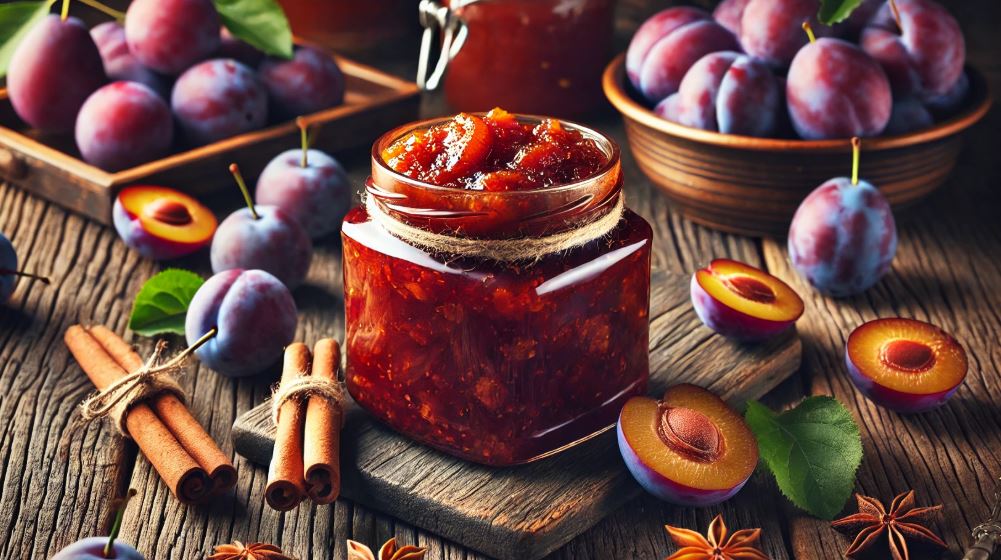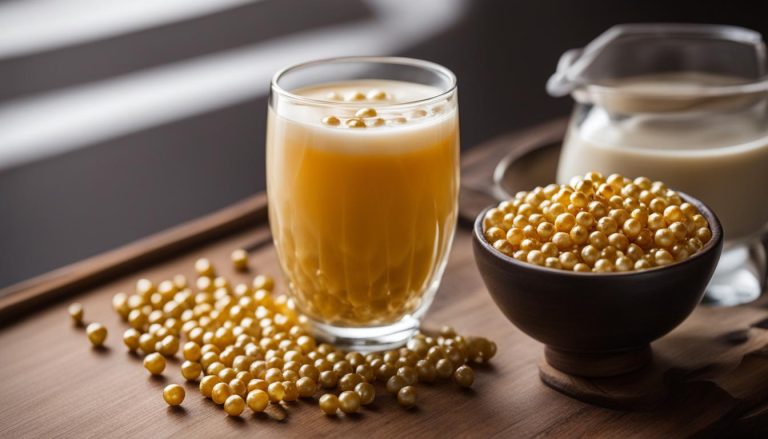Have you ever found yourself with a basket of ripe plums and wondered what to do with them? That’s exactly how my love affair with plum chutney began. This tangy, sweet, and gently spiced preserve has been a British kitchen favourite for generations.
Perfect for cheese boards, roast dinners, or as a thoughtful homemade gift, plum chutney is as versatile as it is delicious. In this plum chutney recipe, I’ll share how to make it beautifully at home.
What is Plum Chutney?

Plum chutney is a tangy, sweet, and subtly spiced preserve made by cooking ripe plums with vinegar, sugar, and a blend of warming spices. In my kitchen, it has always been a way to capture the best of late summer or early autumn when plums are at their juiciest.
The flavour profile strikes a delicate balance between sweet and savoury, with hints of cinnamon, ginger, cloves, or chilli depending on the recipe.
In British cuisine, chutney has been a staple accompaniment since the colonial era, inspired by Indian preserving traditions but adapted to suit local produce.
Plum chutney works particularly well alongside cheese boards, roasted meats, and hearty pies, making it a true all-rounder for the colder months.
What makes plum chutney special is its ability to improve with age. When stored correctly, the flavours mellow and develop over several weeks, creating a richer, deeper taste. This is why I often prepare it well before Christmas to ensure it’s perfect for festive feasts.
Some key characteristics of a well-made plum chutney:
- Thick but spoonable texture
- Visible chunks of fruit
- Balanced acidity and sweetness
- Gentle warmth from spices without overpowering the plums
Ingredients for Plum Chutney Recipe UK
| Quantity | Ingredient | Specifications / Notes |
| 1 kg | Ripe plums | Stoned and roughly chopped; Victoria or Marjorie Seedling work best |
| 500 g | Soft brown sugar | Adds depth and molasses notes |
| 300 ml | Malt vinegar | Traditional choice for tang |
| 300 g (2 medium) | Red onion | Finely chopped |
| 3 cloves | Garlic | Crushed or finely grated |
| 25 g | Fresh ginger | Peeled and finely chopped |
| 1 tsp | Ground cinnamon | Warm spice base |
| 1 tsp | Ground allspice | For subtle complexity |
| ½ tsp | Dried chilli flakes | Optional, for heat |
| 1 tsp | Salt | Balances flavours |
These quantities are designed to make approximately six 200 ml jars. I recommend sterilising jars beforehand to ensure freshness. Choosing ripe but firm plums gives the chutney a better texture, preventing it from becoming overly mushy during cooking.
Step-by-Step Method for the Perfect Plum Chutney

Making plum chutney is less about speed and more about patience. The cooking process is slow, allowing the fruit, vinegar, and sugar to meld into a harmonious balance.
Step-by-step process:
- Prepare the plums by washing, stoning, and chopping them into chunks.
- Finely chop onions, garlic, and ginger so they integrate smoothly.
- Place all ingredients in a large, heavy-based saucepan or preserving pan.
- Bring to the boil over medium heat, stirring to dissolve the sugar.
- Reduce to a gentle simmer, stirring occasionally to prevent sticking.
- Cook for 1–1.5 hours until thickened; the chutney should leave a clear trail when you drag a wooden spoon through the pan.
- Ladle into sterilised jars while hot, seal immediately, and label.
Allow the chutney to mature in a cool, dark place for at least four weeks before opening. This resting time allows the sharp vinegar flavour to mellow, giving a rounded, well-blended taste.
How to Store and Preserve Plum Chutney?
Storing chutney properly ensures it keeps for months without losing flavour or texture. I’ve always found that sterilising jars is the single most important step.
Storage tips:
- Wash jars and lids thoroughly in hot, soapy water and rinse well.
- Sterilise in an oven at 140°C for 15 minutes or by boiling in water.
- Fill jars while both the chutney and jars are still hot to create a vacuum seal.
- Store sealed jars in a cool, dark place for up to 12 months.
- Once opened, refrigerate and consume within 6–8 weeks.
Preserving techniques date back centuries, and vinegar remains one of the safest natural preservatives. The high sugar content also helps inhibit microbial growth.
Combining these two elements creates an environment where chutney can be safely stored long-term without refrigeration until opened.
Serving Ideas for Plum Chutney in British Kitchens

Plum chutney is one of the most versatile condiments in my pantry. Its sweet-sour balance makes it equally at home in savoury and slightly sweet dishes.
Serving ideas:
- Spread on crusty bread with mature Cheddar for a quick lunch.
- Add to a cheeseboard alongside Stilton and oatcakes.
- Serve with roast pork, duck, or lamb for a fruity counterpoint.
- Spoon into sandwiches or wraps for a tangy layer of flavour.
- Mix into gravies or sauces for a subtle fruity depth.
Because plum chutney pairs with both hearty winter dishes and lighter summer platters, it earns its place on the table year-round. I often make extra in September so it’s ready for festive meals and New Year gatherings.
Tips for Balancing Sweetness and Spice in Plum Chutney
Achieving the perfect balance in plum chutney comes down to proportion and timing. Too much sugar will make it cloying; too much vinegar will make it harsh. I always taste as I go, adjusting small amounts of spice or sweetness as the mixture cooks.
Helpful guidelines:
- Use brown sugar for a deeper, caramel-like sweetness.
- Add vinegar early in cooking so the harsh acidity has time to mellow.
- Start with less chilli than you think you need, the heat intensifies over time.
- Add whole spices early, ground spices later, to avoid bitterness.
Common Mistakes to Avoid When Making Plum Chutney
Avoiding common errors can save a batch from becoming unbalanced or unusable:
- Rushing the cooking process, chutney needs slow simmering.
- Not sterilising jars risks spoilage.
- Using overripe plums they can turn the chutney mushy.
- Overpowering the fruit with too much spice.
Each of these can be corrected with a little care and attention, but prevention is always better.
Health Benefits of Plums and Homemade Chutney

Plums are rich in vitamins, antioxidants, and dietary fibre, making them a valuable addition to the diet. While chutney does contain sugar, homemade versions often use less than commercial ones and avoid unnecessary additives.
Nutritional Table (per 20g serving of homemade plum chutney)
| Nutrient | Amount |
| Calories | 28 kcal |
| Carbohydrates | 6.5 g |
| Sugars | 5.8 g |
| Fibre | 0.4 g |
| Fat | 0.1 g |
| Protein | 0.2 g |
| Sodium | 45 mg |
| Vitamin C | 3% RDA |
Eating chutney in moderation can complement a balanced diet, particularly when paired with nutrient-rich meals.
Variations of Plum Chutney Recipe UK
Nigel Slater’s Hot Sweet Plum Chutney
Nigel Slater’s version leans into bold spice and chilli heat, combining ripe plums with muscovado sugar and a healthy dose of fresh ginger. The result is a chutney that’s both comforting and invigorating, perfect for pairing with grilled meats or strong cheeses.
Jamie Oliver’s Spiced Plum Chutney
Jamie’s recipe focuses on layering flavours, using star anise, cinnamon, and cloves alongside plums. It’s slightly sweeter than most versions and pairs beautifully with Christmas ham.
BBC Good Food’s Richly Spiced Plum Chutney
This recipe builds complexity with coriander seeds, cardamom pods, and fresh red chillies. It’s ideal for anyone wanting a chutney with both fragrance and a gentle kick.
BaldHiker’s Tangy and Delicious Plum Chutney
Here, tangy vinegar notes take centre stage, balanced by minimal sugar and a light touch of spice. Perfect for those who prefer a sharper chutney.
Oventales’ Warm Spiced Plum Chutney
This version adds cinnamon sticks and fresh ginger for a warming finish. It’s a comforting chutney for cold-weather meals.
Conclusion
Plum chutney is more than just a condiment, it’s a way of preserving the season’s bounty and adding a burst of flavour to everyday meals.
With a careful balance of sweetness, spice, and tang, it can elevate even the simplest of dishes. By making your own, you control every ingredient, ensuring freshness and quality.
Whether for festive gatherings, casual lunches, or thoughtful gifts, this British classic is a recipe worth mastering and enjoying year after year.
FAQs
How long should plum chutney mature before eating?
I recommend letting it rest for at least four weeks after making it. This allows the sharp vinegar flavour to mellow and the spices to blend beautifully.
Can I freeze plum chutney instead of storing it in jars?
Yes, but chutney freezes best in airtight containers. Thaw in the fridge and consume within a week for the best texture and taste.
What’s the best type of plum for chutney?
Victoria plums are my go-to for their balance of sweetness and tartness. However, Marjorie Seedling and Opal plums also make excellent chutneys.
How can I make my chutney less sweet?
Reduce the sugar slightly and use more tart plums. Be aware this may shorten the chutney’s shelf life, so store in the fridge once opened.
Is plum chutney vegan-friendly?
Yes, most traditional recipes are naturally vegan as they use only fruit, sugar, vinegar, and spices. Always check vinegar labels to ensure suitability.

Plum Chutney Recipe
Ingredients
- 1 kg Ripe plums Stoned and roughly chopped; Victoria or Marjorie Seedling work best
- 500 g Soft brown sugar Adds depth and molasses notes
- 300 ml Malt vinegar Traditional choice for tang
- 300 g Red onion 2 medium, Finely chopped
- 3 cloves Garlic Crushed or finely grated
- 25 g Fresh ginger Peeled and finely chopped
- 1 tsp Ground cinnamon Warm spice base
- 1 tsp Ground allspice For subtle complexity
- ½ tsp Dried chilli flakes Optional for heat
- 1 tsp Salt Balances flavours
Instructions
- Prepare the plums by washing, stoning, and chopping them into chunks.1 kg Ripe plums
- Finely chop onions, garlic, and ginger so they integrate smoothly.300 g Red onion, 3 cloves Garlic, 25 g Fresh ginger
- Place all ingredients in a large, heavy-based saucepan or preserving pan.300 ml Malt vinegar, 1 tsp Ground cinnamon, 1 tsp Ground allspice, ½ tsp Dried chilli flakes, 1 tsp Salt
- Bring to the boil over medium heat, stirring to dissolve the sugar.500 g Soft brown sugar
- Reduce to a gentle simmer, stirring occasionally to prevent sticking.
- Cook for 1–1.5 hours until thickened; the chutney should leave a clear trail when you drag a wooden spoon through the pan.
- Ladle into sterilised jars while hot, seal immediately, and label.









